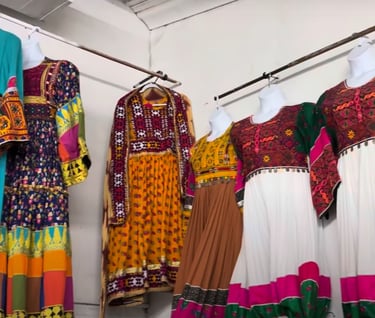Afghan Traditional Clothing
CULTURE
Traditional clothing in Afghanistan varies from one region to another. This is influenced by local climate, lifestyle, and ethnic traditions. In the colder northern and mountainous areas, people tend to wear heavier and layered clothes. In contrast, in the warmer southern regions, lighter clothing is preferred.
Jirga: Traditional Afghan clothing reflects the country’s rich cultural heritage, regional diversity, and historical influences. The clothes worn by Afghans are not only practical but also carry deep cultural and social meanings.
Regional Diversity:
Traditional clothing in Afghanistan varies from one region to another. This is influenced by local climate, lifestyle, and ethnic traditions. In the colder northern and mountainous areas, people tend to wear heavier and layered clothes. In contrast, in the warmer southern regions, lighter clothing is preferred.
Pashton/Pakhton Clothing:
The traditional clothing of the Pakhton ethnic group, one of the largest in Afghanistan, includes the shalwar kameez. This outfit consists of loose-fitting trousers (shalwar) and a long tunic (kameez), often worn with a scarf or turban by men. Women wear a similar outfit, usually decorated with more detailed embroidery and colorful patterns.
Tajik and Hazara Clothing:
Tajiks and Hazaras, among other ethnic groups, have their own distinct traditional clothing. For example, Tajik men might wear a long, embroidered coat called a chapan, while Hazara women often dress in bright, eye-catching outfits adorned with intricate embroidery.
Nomadic and Tribal Clothing:
Nomadic tribes in Afghanistan, such as the Kuchis, have unique clothing styles suited to their mobile way of life. Their outfits may include brightly colored garments, heavy jewelry, and distinctive headwear. These tribal styles are not only practical but also represent their cultural identity.
Modesty and Cultural Importance:
Traditional Afghan clothing emphasizes modesty, with loose-fitting garments that cover the body. The choice of colors, fabrics, and embroidery often has cultural and regional significance, and clothing can reflect a person's social status or marital situation.
Clothing for Special Occasions:
For special events and celebrations, Afghans wear vibrant and beautifully decorated outfits, often featuring beadwork, embroidery, and detailed jewelry. Weddings, festivals, and religious ceremonies are occasions where people showcase their finest traditional clothing.
Blending with Modern Fashion:
While traditional clothing remains important, urbanization and modern influences have led to a mix of Western and traditional styles, especially in cities like Kabul. Many Afghans now wear a combination of traditional and modern clothing, reflecting changing lifestyles and global fashion trends.
Traditional Afghan clothing is more than just what people wear. It is a vibrant expression of the country’s cultural diversity, history, and identity. It serves as a visual reminder of the rich traditions that have shaped Afghan society for centuries.


